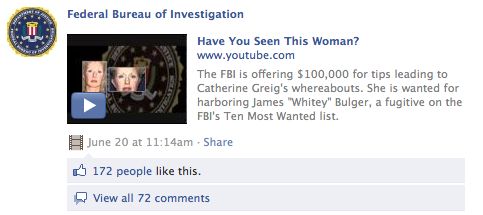Is social media ready to find the missing?
Back when we all spent a lot more time at the post office, the iconic “Wanted” poster was a particularly effective form of reaching a captive audience hailing from all walks of life – after all, everyone needed to send a letter now and then, and if you were in the business of trying to catch criminals who’d reinvented themselves as who-knows-what, you’d want to reach as broad of a demographic as possible. In 2007, when the FBI started posting wanted notices on digital billboards nationwide, it was a similarly wide-ranging effort: Cast your advertising dragnet over a major highway, and you’ll reach people of all ages, interests and backgrounds.

So when it was announced that the 16-year-old search for notorious Massachusetts mobster Whitey Bulger ended less than a week after being reinvigorated by a new tv-and-social-media search campaign, it seemed like a pretty obvious match of need and medium. After all, in an age when it takes most of us months to work through a book of stamps, social media isn’t only our new post office – it’s our new community center, bingo hall and workplace water cooler.
Except for one thing that didn’t make it through the first round of “caught the bad guy” news: It wasn’t Twitter or Facebook that alerted a tipster to Bulger’s girlfriend (the focus of the FBI’s reworked wanted campaign) but a TV spot. A Boston Globe article that ran June 21 didn’t even mention social media, concentrating instead on the campaign’s push via daytime TV. Said FBI Supervisory Special Agent Richard Teahan in the article: “We’re looking for people sitting in a hospital waiting for an appointment with a doctor where there are three or four [television] monitors on the wall, and they are watching these shows . . . or people who are in a beauty salon or barber shop.”
So does that mean the social media prong of the Bulger manhunt was a failure? Not so fast. For one thing, there’s “first time for everything” syndrome to consider. While the FBI’s two Facebook posts announcing the hunt only have at time of writing 298 “likes” and 72 comments out of the page’s 117,931 fans, it’s certainly a start. Plus, now we all know that the FBI is announcing fugitives via social media – how many us were aware of this before Bulger’s capture?
However, as with any new social media effort, searching for missing persons via social networks may be a difficult battle until the the practice gains critical mass. The National Center for Missing & Exploited Children’s Twitter account, @OurMissingKids, has only 209 followers – but @Amber_Alert has 26,763. After the social media search for Indiana University student Lauren Spierer, who went missing early this month, made national headlines, follower counts on the social accounts devoted to finding her skyrocketed; the Twitter account @NewsOnLaurenS has 25,751 followers. In other words, it may simply be a matter of time – but unfortunately, when it comes to finding the missing, time is of the essence.
What do you think about using social to find missing persons, whether the wanted or the disappeared? Is the medium ready to truly make a difference? Let us know your opinions in the comments.

